I started this project with VitaminQ Sprague PIO 0.10uf cap in the incoming cap postion of my Clarinet. The remaining 1.0uf caps were DynamiCaps.

The sound is exceptionally three dimensional--in fact it can almost sound more 3D than the actual recording. The PIO provide loads of detail without etchy aftertaste. While I love the midrange they simply do not flesh out the midbass lines very well. They are bloated and round vs detailed and expressive. What kills the magic most for me is that they roll off the highs so I hear less of the hall or recording venue.
I just spun in some Russian T-3 0.10uf teflon caps to see what would happen with the sound. I also spun in a 0.10 K40y9 PIO bypass cap on the B+ 47uf caps after the two 10k drop down resistors. With these changes the highs immediately improved. Dynamics are now so fast and so percussive that the sound quality is simply off the chart. However the low bass is now thin compared to the meat and potatos sound I was getting with those PIO caps.
I guess I could over simplify the sound change as describing it as a shift from too much lows and mids to too much upper mids and highs.ADDED 12/5/2007:
On the Clarinet there are two sets of Caps in line with the signal. The first set are 0.10uf and JimH mentioned these could be deleated as long as your equipment is not passing any DC signal. The second set is a 1.0uf cap. On my Clarinet project I installed DynamiCaps in the 1.0uf positions both in line and as decoupling caps.
On the 0.10uf position I started with a pair of Sprague VitaminQ PIO caps. These have the most amazing midrange I have heard with my Clarinet. The bass is full and blooms nicely. I actually prefer tight and defined bass like I hear with my pure passive preamp, but the difference in sound is fun. Different can be good at times.
My first cap roll was to a 0.10uf Russian T-3 Teflon cap. These are big buggers. The sound immediately tilted up and upper midrange and highs were simply off the charts. These are hugely dynamic critters and the sound is fast and effortless but lacks the deep sound staging and full bass lines in the PIO caps.
Then I tried the K40Y9 0.10uf PIO cap. This sounds a lot like the VitaminQ but lacks a taste of the exemplary midrange growl these caps exhibit. It has an excellent 3 dimensional sound field and has a very decent bass response. I also tried bypassing this with a 0.01uf mylar cap to pick up a little more highs. It was a decent combination.
Then I tried the 0.10 VitaminQ paralleled to a 0.10 T-3 Teflon and it sounded similar to the K40y9 with the mylar bypass cap. With twice the capacitance I was expecting to hear something change in the sound.
Last night I got in a set of DynamiCap 0.10 and I ran these. They sound nearly identical to the PIO bypassed caps I have evaluated.
I also found I was overloading the circuit. Apparently the balance control is a 50k pot and in center position each channel is showing the circuit 25k resistance. I also soldered in a 25k S102 nude Vishay in line to replicate this pot.
Tonight I am going to try that Russian Teflon another time. Perhaps with the extra resistance it will tame its overly bright tilt. Or perhaps the Teflon cap might take more break in time to get some bigger bass. If the Teflon sounds great with the extra resistance it might be worth buying a quality USA Teflon cap just to see if I can get my cake and eat it too.
Thank you JimH for designing such a wonderful line preamp. This item really wakes up the sound in my little apartment and makes quieter listening times more enjoyable.